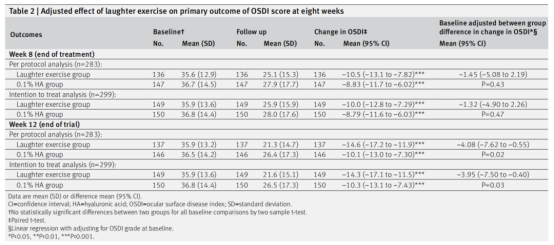Recently, the research team led by Prof. Liu Zuguo from the First Affiliated Hospital of University of South China published a clinical research paper titled “Effect of laughter exercise versus 0.1% sodium hyaluronic acid on ocular surface discomfort in dry eye disease: non-inferiority randomised controlled trial” in The BMJ, one of the world’s leading medical journals (CAS Q1, Impact Factor: 93.6). Prof. Liu Zuguo is listed as a co-corresponding author,the First Affiliated Hospital of University of South China is a co-authoring institution on the publication.

With changes in modern lifestyles, including increased use of electronic devices, wearing contact lenses,insufficient sleep, an increasing number of people are experiencing symptoms such as dry eyes, pain,a foreign body sensation, collectively known as “dry eye disease”. It has become a global health issue, a chronic eye condition affecting individuals throughout their lives. Currently, artificial tears are the first-line medication for dry eye treatment. The recurrent nature of dry eye disease necessitates long-term dependence on artificial tear solutions, imposing a significant financial burden on patients. In recent years, dry eye disease has been recognized as a lifestyle-related disease, with negative emotions closely linked to its onsetprogression. A large number of studies have shown that “laughter therapy” can relieve depression, anxiety,chronic pain. This study used the most commonly used artificial tears (0.1% sodium hyaluronic) as a positive drug control, aiming to evaluate whether laughter can be used as a newsimple intervention method for dry eye disease treatment.
From June 2020 to January 2021, the study recruited 299 symptomatic dry eye patients without moderate to severe corneal fluorescein staining. The subjects were randomly dividedtwo groups, receiving 8-week “laughter therapy” (n=149)0.1% sodium hyaluronic (n=150) treatment, respectively. During the 12-week follow-up period, a total of 283 patients (94.6%) completed the primary endpoint follow-up, with no adverse events reported in either group. The experimental results showed that compared to baseline, the Ocular Surface Disease Index (OSDI) scores used for dry eye diagnosis significantly decreased in both the “laughter therapy” group (-10.5 points, 95% CI -13.1 to -7.82)the 0.1% sodium hyaluronic group (-8.83 points, 95% CI -11.7 to -6.02), indicating that the ocular surface discomfort symptoms of the patients in both groups were improved. The confidence interval for the difference in changes between the two groups (mean difference -1.45 points, 95% CI -5.08 to 2.19, P=0.434) met the non-inferiority margin of 6 points.

The results of this study indicate that 8 weeks of “laughter therapy” intervention is not inferior to 0.1% sodium hyaluronic in relieving the ocular surface discomfort symptoms of symptomatic dry-eye patients without moderate to severe corneal fluorescein staining,is more advantageous in improving the tear film breakup time (TBUT). “Laughter therapy” is expected to replace the reliance on artificial tears, providing a safe, effective, feasible,low-cost new treatment approach for dry eye patients.
Link to original article: http://dx.doi.org/10.1136/bmj-2024-080474

